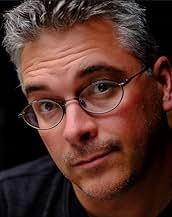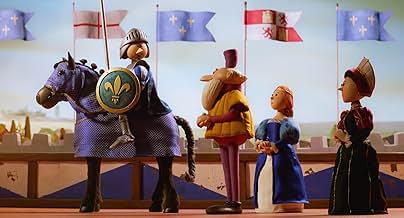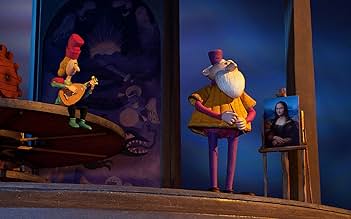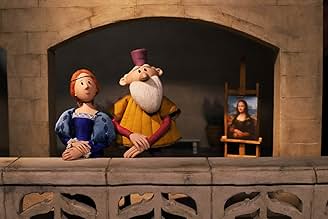IMDb RATING
5.8/10
827
YOUR RATING
Inventing flying contraptions, war machines and studying cadavers, Leonardo da Vinci tackles the meaning of life itself with the help of French princess Marguerite de Nevarre.Inventing flying contraptions, war machines and studying cadavers, Leonardo da Vinci tackles the meaning of life itself with the help of French princess Marguerite de Nevarre.Inventing flying contraptions, war machines and studying cadavers, Leonardo da Vinci tackles the meaning of life itself with the help of French princess Marguerite de Nevarre.
- Directors
- Writer
- Stars
- Awards
- 1 win & 3 nominations total
Daisy Ridley
- Marguerite
- (voice)
Matt Berry
- Pope Leo X
- (voice)
Stephen Fry
- Leonardo da Vinci
- (voice)
Aaron Heffernan
- Crowd
- (voice)
Ben Stranahan
- Page
- (voice)
Jim Capobianco
- The Physician
- (voice)
- …
Pierre-Luc Granjon
- Pierre-Luc
- (voice)
Jane Osborn
- Gravedigger Jane
- (voice)
Marion Charrier
- Annette
- (voice)
Teemu Oksanen
- Crowd
- (voice)
Janan Abir
- Crowd
- (voice)
Cristen Schwab
- Crowd
- (voice)
- Directors
- Writer
- All cast & crew
- Production, box office & more at IMDbPro
Featured reviews
The insatiably curious and headstrong inventor Leonardo da Vinci leaves Italy to join the French court. Leonardo da Vinci spent the last three years of his life in Amboise, France. He arrived there in the autumn of 1516, having accepted an invitation from King Francis I and his mother Louise of Savoy, who welcomed him with open arms at the Château d'Amboise, the young monarch's favourite residence. In 1515, the French king invited Leonardo to the royal summer home, Château du Clos Lucé, near Amboise. There, Leonardo carries out a feverish activity: inventing flying contraptions, war machines, studying cadavers and the human body. Leonardo da Vinci tackles the meaning of life itself .There, joined in his adventure by the audacious princess Marguerite, Leonardo will uncover the answer to questions about life. Imagination takes flight !. What is the meaning of it all?
An acceptable and passable Stop-motion movie, being nominated for the best animated feature film at the 2023 Annecy Festival. Here the last years of Leonardo's life are developed, after having had problems with the Catholic Church, specifically Pope Leo X. The film addresses the meaning of life itself, and the process of building an ideal city, and his relationship with the King of France, Francis I, and especially the friendship with his sister, the French princess Margarita of Navarre. Adding brief appearances by Emperor Charles V of Germany and Henry VIII of England who fight and contend with King Francis I of France. Being written and directed by Jim Capobianca, although the script fails a lot because it does not properly develop the story and becomes somewhat heavy and boring. Capobianco was the original screenwriter of the successful Ratatouille. In the original version it features the voices of Stephen Fry, Daisy Ridley, Matt Berry and Marion Cotillard, among others.
The film is based on biographical facts about Leonardo: In 1516, one year after his coronation, Francis I invited the famous Italian genius Leonardo da Vinci to settle in Amboise. At the age of 64, Leonardo da Vinci, who no longer enjoyed the recognition of Rome and was particularly at odds with the Medici, who preferred Raphael or Michelangelo, accepted Francis I's invitation. For Francis I, Leonardo's presence would bring lustre to the French court and encourage further cultural and artistic development of the French court. The kings of France had always wanted to equal the Italian courts. Leonardo was a sought-after artist but his Italian protector, Giuliano II de Medici, had died prematurely. This allowed da Vinci to accept the invitation of the king of France. Thus, on May 16, after a three-month long journey, after crossing the Alps on mules, he arrived in Amboise, a beautiful town in the Loire Valley, with some of his disciples and three of his favourite paintings: the portrait of the Mona Lisa, the Virgin and Child with Saint Anne and a Saint John the Baptist that he finished painting here. Francis I made the Château de Clos Lucé available to Leonardo da Vinci to live in. He also granted him an income of 700 gold crowns a year, financed his works and only asked him in return for the pleasure of listening to him converse, something he enjoyed almost every day until the genius' death. He also organised numerous parties for the king. Leonardo is also believed to have been involved in the original design of the Château de Chambord, the construction of which began shortly after da Vinci's death. He also brought with him numerous drawings as well as three emblematic and very important paintings for Leonardo: "La Gioconda", "Saint John the Baptist" and "The Virgin, the Child Jesus and Saint Anne", paintings on which he worked for many years. It was his wish to bring these paintings to France. In fact, it was in Amboise that he put the finishing touches to 'Saint Anne', a painting on which he worked for more than 15 years. And shortly before Leonardo's death, Francis I bought the three paintings. That is why today these paintings are in the Louvre, together with two other paintings, 'The Virgin of the Rocks' and 'La Belle Ferronière', that means that one third of da Vinci's pictorial work is in France.
An acceptable and passable Stop-motion movie, being nominated for the best animated feature film at the 2023 Annecy Festival. Here the last years of Leonardo's life are developed, after having had problems with the Catholic Church, specifically Pope Leo X. The film addresses the meaning of life itself, and the process of building an ideal city, and his relationship with the King of France, Francis I, and especially the friendship with his sister, the French princess Margarita of Navarre. Adding brief appearances by Emperor Charles V of Germany and Henry VIII of England who fight and contend with King Francis I of France. Being written and directed by Jim Capobianca, although the script fails a lot because it does not properly develop the story and becomes somewhat heavy and boring. Capobianco was the original screenwriter of the successful Ratatouille. In the original version it features the voices of Stephen Fry, Daisy Ridley, Matt Berry and Marion Cotillard, among others.
The film is based on biographical facts about Leonardo: In 1516, one year after his coronation, Francis I invited the famous Italian genius Leonardo da Vinci to settle in Amboise. At the age of 64, Leonardo da Vinci, who no longer enjoyed the recognition of Rome and was particularly at odds with the Medici, who preferred Raphael or Michelangelo, accepted Francis I's invitation. For Francis I, Leonardo's presence would bring lustre to the French court and encourage further cultural and artistic development of the French court. The kings of France had always wanted to equal the Italian courts. Leonardo was a sought-after artist but his Italian protector, Giuliano II de Medici, had died prematurely. This allowed da Vinci to accept the invitation of the king of France. Thus, on May 16, after a three-month long journey, after crossing the Alps on mules, he arrived in Amboise, a beautiful town in the Loire Valley, with some of his disciples and three of his favourite paintings: the portrait of the Mona Lisa, the Virgin and Child with Saint Anne and a Saint John the Baptist that he finished painting here. Francis I made the Château de Clos Lucé available to Leonardo da Vinci to live in. He also granted him an income of 700 gold crowns a year, financed his works and only asked him in return for the pleasure of listening to him converse, something he enjoyed almost every day until the genius' death. He also organised numerous parties for the king. Leonardo is also believed to have been involved in the original design of the Château de Chambord, the construction of which began shortly after da Vinci's death. He also brought with him numerous drawings as well as three emblematic and very important paintings for Leonardo: "La Gioconda", "Saint John the Baptist" and "The Virgin, the Child Jesus and Saint Anne", paintings on which he worked for many years. It was his wish to bring these paintings to France. In fact, it was in Amboise that he put the finishing touches to 'Saint Anne', a painting on which he worked for more than 15 years. And shortly before Leonardo's death, Francis I bought the three paintings. That is why today these paintings are in the Louvre, together with two other paintings, 'The Virgin of the Rocks' and 'La Belle Ferronière', that means that one third of da Vinci's pictorial work is in France.
Leonardo da Vinci was one of the most fascinating men who ever lived, but this film fails to do him justice.
Quirkily animated (part puppetry, part cartoon) it centres on the last years of da Vinci's life, when he joined the court of the French King Francis I. His most famous paintings (the Mona Lisa and the Last Supper) are referenced, as are his plans for eccentric machines of war, but we see nothing of their creation.
Instead, the film concentrates on da Vinci's plan for an ideal city (which never got beyond the planning stage) and preparations for an important royal summit.
The latter is presumably meant to be the Field of Cloth of Gold, at which Francis and Henry VIII of England tried to out-do each other in ostentation. For some reason, a third potentate is added - the Holy Roman Emperor Charles V, who was not present. Worse, the film ignores the fact that da Vinci had died the previous year.
There's much to like here. The voice performances are excellent, especially Stephen Fry as da Vinci; and there's a decent amount of humour amidst the philosophising.
Unfortunately, however, the film can't quite make up its mind what it's trying to do. This may be because of the extraordinary number of production companies involved in making it, resulting in a hodge-podge of compromises from a dysfunctional committee.
An interesting film, but ultimately a disappointing one.
Quirkily animated (part puppetry, part cartoon) it centres on the last years of da Vinci's life, when he joined the court of the French King Francis I. His most famous paintings (the Mona Lisa and the Last Supper) are referenced, as are his plans for eccentric machines of war, but we see nothing of their creation.
Instead, the film concentrates on da Vinci's plan for an ideal city (which never got beyond the planning stage) and preparations for an important royal summit.
The latter is presumably meant to be the Field of Cloth of Gold, at which Francis and Henry VIII of England tried to out-do each other in ostentation. For some reason, a third potentate is added - the Holy Roman Emperor Charles V, who was not present. Worse, the film ignores the fact that da Vinci had died the previous year.
There's much to like here. The voice performances are excellent, especially Stephen Fry as da Vinci; and there's a decent amount of humour amidst the philosophising.
Unfortunately, however, the film can't quite make up its mind what it's trying to do. This may be because of the extraordinary number of production companies involved in making it, resulting in a hodge-podge of compromises from a dysfunctional committee.
An interesting film, but ultimately a disappointing one.
A delight, especially for those who enjoy history. This multi-style animated feature tells the story of Leonardo DaVinci's later life.
Spurning trendy 3D-driven computer animation with its dense content and over-caffeinated dialog, this film takes its time, spreads out, and dives deeply and gracefully into "The Maestro's" Italy and France that he inhabits. The primary animation style is 3D stop motion puppetry, but there is nothing old and jerky about this production. The motion is smooth, the backgrounds lush and detailed, and the pace measured and deliberate. With the occasional nod to old-fashioned elements (DaVinci's mouth that magically appears atop his thick beard when he speaks, for example), the puppetry is truly state-of-the-art.
King Francis I, King Henry VIII, King Charles I, and Pope Leo X all do the comedic heavy lifting. The scenes where the three monarchs repeatedly bicker and fight provide pure, fast-paced, and traditional animated delight, especially since these scenes are all stop motion. As the real world becomes too intense, threatening and ignorant to our hero, we are offered frequent glimpses of the world inside DaVinci's mind, and are treated with sepia-infused, gravity-defying, pencil animated scenes of pure joy, in an animated style reminiscent of DaVinci's famous sepia sketches come to life.
The score is subtle, with a noticeable lack of big, defining tunes. Instead, the songs - mostly offered by the princess (arguable the most impressive character of the movie with her understated progressivism and uncanny and hilarious ability to manager her brother, the French monarch) - seem to start and stop seamlessly with the dialog. The score weaves from lush support, to hints of Renaissance music (hinting at the Elizabethan period to come as ushered in by our hero), to a bizarre but effective hook melody in a 6/8-3/4 time signature reminiscent of Bernstein's America.
As said, a delight. An animated romp through Renaissance history with this tale teaching us that the primary agent of change, DaVinci, was no ordinary inventor.
Spurning trendy 3D-driven computer animation with its dense content and over-caffeinated dialog, this film takes its time, spreads out, and dives deeply and gracefully into "The Maestro's" Italy and France that he inhabits. The primary animation style is 3D stop motion puppetry, but there is nothing old and jerky about this production. The motion is smooth, the backgrounds lush and detailed, and the pace measured and deliberate. With the occasional nod to old-fashioned elements (DaVinci's mouth that magically appears atop his thick beard when he speaks, for example), the puppetry is truly state-of-the-art.
King Francis I, King Henry VIII, King Charles I, and Pope Leo X all do the comedic heavy lifting. The scenes where the three monarchs repeatedly bicker and fight provide pure, fast-paced, and traditional animated delight, especially since these scenes are all stop motion. As the real world becomes too intense, threatening and ignorant to our hero, we are offered frequent glimpses of the world inside DaVinci's mind, and are treated with sepia-infused, gravity-defying, pencil animated scenes of pure joy, in an animated style reminiscent of DaVinci's famous sepia sketches come to life.
The score is subtle, with a noticeable lack of big, defining tunes. Instead, the songs - mostly offered by the princess (arguable the most impressive character of the movie with her understated progressivism and uncanny and hilarious ability to manager her brother, the French monarch) - seem to start and stop seamlessly with the dialog. The score weaves from lush support, to hints of Renaissance music (hinting at the Elizabethan period to come as ushered in by our hero), to a bizarre but effective hook melody in a 6/8-3/4 time signature reminiscent of Bernstein's America.
As said, a delight. An animated romp through Renaissance history with this tale teaching us that the primary agent of change, DaVinci, was no ordinary inventor.
**Review: "The Inventor" - A Visual Symphony of Art and Life**
The magic of cinema takes various shapes and forms, but few as mesmerizing as "The Inventor". The film is not only a love letter to Leonardo da Vinci's later years but also a masterpiece that combines the intricate art of stop motion animation with an emotionally captivating narrative.
From the moment the movie begins, the audience is transported into a breathtakingly crafted world that is not only aesthetically awe-inspiring but also teeming with intricate details. Jim Capobianco, an Academy Award nominee, showcases his prowess by weaving a tapestry of rich, historical narrative that marries fact with fiction, transporting viewers directly to da Vinci's side as he navigates the courts of France, searching for life's meaning.
Da Vinci, voiced by the inimitable Stephen Fry, is portrayed with such depth and gravitas that one could almost forget that they are listening to a voice and not actually sitting across from the genius himself. Fry's performance is both nuanced and powerful, infusing the film with an emotional anchor that draws the audience into Leonardo's world of innovation and introspection.
Marion Cotillard, an Oscar winner, lends her voice to a character that complements and contrasts with da Vinci in a beautiful dance of words and emotions. Daisy Ridley and Matt Berry also shine in their respective roles, adding layers of complexity to this rich tapestry of characters.
But the heart of the film lies in its visuals. Stop motion animation has long been an avenue for cinematic magic, but "The Inventor" elevates it to a new level. Each frame is a testament to countless hours of meticulous work, creating a fluidity of motion that is so lifelike it's staggering. The film's palette, drenched in the warm hues of the Renaissance, only serves to further its beauty, making each scene a work of art in and of itself.
What's even more surprising is how accessible this seemingly adult-centric narrative is for younger audiences. My 8-year-old daughter was completely captivated by it, her eyes glued to the screen from start to finish. While I initially thought the subject might be a tad mature for her, the film seamlessly balances its complex themes with moments of levity and wonder, making it universally engaging.
The underlying theme of the movie - the search for life's meaning - is one that resonates deeply. As Leonardo tinkers with flying contraptions, immerses himself in studies of the human body, and crafts machines that were far ahead of his time, we are left pondering our own journeys and our pursuits of purpose. The film doesn't just tell da Vinci's story; it challenges us to look inward and ask ourselves about our own passions and our quest for understanding.
Moreover, the film's sound design and score cannot be ignored. The intricate layers of ambient sounds, from the rustling of papers to the distant chatter of courtiers, envelop you in a soundscape that's as detailed as the visuals. The score, sweeping and evocative, only adds another layer of depth to this masterpiece.
In conclusion, "The Inventor" is not just a movie; it's an experience. It captures the essence of a man who was centuries ahead of his time, and it does so with grace, beauty, and heart. This is one of those rare films that not only entertains but also educates and inspires. Though it might not resonate with everyone in the same way, it was undeniably a pinnacle of entertainment for me. I'd watch it again and again, relishing in its details, pondering its questions, and simply basking in its visual splendor. Jim Capobianco's "The Inventor" is, without doubt, a cinematic triumph.
The magic of cinema takes various shapes and forms, but few as mesmerizing as "The Inventor". The film is not only a love letter to Leonardo da Vinci's later years but also a masterpiece that combines the intricate art of stop motion animation with an emotionally captivating narrative.
From the moment the movie begins, the audience is transported into a breathtakingly crafted world that is not only aesthetically awe-inspiring but also teeming with intricate details. Jim Capobianco, an Academy Award nominee, showcases his prowess by weaving a tapestry of rich, historical narrative that marries fact with fiction, transporting viewers directly to da Vinci's side as he navigates the courts of France, searching for life's meaning.
Da Vinci, voiced by the inimitable Stephen Fry, is portrayed with such depth and gravitas that one could almost forget that they are listening to a voice and not actually sitting across from the genius himself. Fry's performance is both nuanced and powerful, infusing the film with an emotional anchor that draws the audience into Leonardo's world of innovation and introspection.
Marion Cotillard, an Oscar winner, lends her voice to a character that complements and contrasts with da Vinci in a beautiful dance of words and emotions. Daisy Ridley and Matt Berry also shine in their respective roles, adding layers of complexity to this rich tapestry of characters.
But the heart of the film lies in its visuals. Stop motion animation has long been an avenue for cinematic magic, but "The Inventor" elevates it to a new level. Each frame is a testament to countless hours of meticulous work, creating a fluidity of motion that is so lifelike it's staggering. The film's palette, drenched in the warm hues of the Renaissance, only serves to further its beauty, making each scene a work of art in and of itself.
What's even more surprising is how accessible this seemingly adult-centric narrative is for younger audiences. My 8-year-old daughter was completely captivated by it, her eyes glued to the screen from start to finish. While I initially thought the subject might be a tad mature for her, the film seamlessly balances its complex themes with moments of levity and wonder, making it universally engaging.
The underlying theme of the movie - the search for life's meaning - is one that resonates deeply. As Leonardo tinkers with flying contraptions, immerses himself in studies of the human body, and crafts machines that were far ahead of his time, we are left pondering our own journeys and our pursuits of purpose. The film doesn't just tell da Vinci's story; it challenges us to look inward and ask ourselves about our own passions and our quest for understanding.
Moreover, the film's sound design and score cannot be ignored. The intricate layers of ambient sounds, from the rustling of papers to the distant chatter of courtiers, envelop you in a soundscape that's as detailed as the visuals. The score, sweeping and evocative, only adds another layer of depth to this masterpiece.
In conclusion, "The Inventor" is not just a movie; it's an experience. It captures the essence of a man who was centuries ahead of his time, and it does so with grace, beauty, and heart. This is one of those rare films that not only entertains but also educates and inspires. Though it might not resonate with everyone in the same way, it was undeniably a pinnacle of entertainment for me. I'd watch it again and again, relishing in its details, pondering its questions, and simply basking in its visual splendor. Jim Capobianco's "The Inventor" is, without doubt, a cinematic triumph.
I just watched The Inventor, and I must say, it's a captivating animation film that left me pondering the life of Leonardo da Vinci. As someone who's always been fascinated by art, science, and history, I appreciated the unique blend of these elements in the movie.
One of the standout aspects of The Inventor is its stunning animation. The watercolor-inspired visuals transported me to the Renaissance era, immersing me in the world of 15th-century Florence. The attention to detail in the characters' designs and the environments is impressive, making every scene a feast for the eyes.
The storytelling is engaging, and I enjoyed seeing Leonardo's curiosity and creativity shine through. The film highlights his inventive spirit, showcasing his iconic designs and innovations. However, I felt that the narrative was a bit disjointed at times, jumping between different periods of Leonardo's life without clear transitions.
My only other criticism is that the supporting characters feel somewhat one-dimensional. I would have loved to see more depth and development in characters like Lorenzo and Francesco.
Despite these minor flaws, The Inventor is a charming film that sparked my interest in Leonardo's life and work. The movie's themes of creativity, perseverance, and innovation resonated with me, and I found myself reflecting on my own passions and pursuits.
Overall, I'd recommend The Inventor to anyone interested in art, history, or science. While it may not be a perfect film, its unique visual style and captivating storyline make it a worthwhile watch.
One of the standout aspects of The Inventor is its stunning animation. The watercolor-inspired visuals transported me to the Renaissance era, immersing me in the world of 15th-century Florence. The attention to detail in the characters' designs and the environments is impressive, making every scene a feast for the eyes.
The storytelling is engaging, and I enjoyed seeing Leonardo's curiosity and creativity shine through. The film highlights his inventive spirit, showcasing his iconic designs and innovations. However, I felt that the narrative was a bit disjointed at times, jumping between different periods of Leonardo's life without clear transitions.
My only other criticism is that the supporting characters feel somewhat one-dimensional. I would have loved to see more depth and development in characters like Lorenzo and Francesco.
Despite these minor flaws, The Inventor is a charming film that sparked my interest in Leonardo's life and work. The movie's themes of creativity, perseverance, and innovation resonated with me, and I found myself reflecting on my own passions and pursuits.
Overall, I'd recommend The Inventor to anyone interested in art, history, or science. While it may not be a perfect film, its unique visual style and captivating storyline make it a worthwhile watch.
Did you know
- TriviaMarion Cotillard voiced Louise of Savoy in both the English and the French version of the film.
- GoofsMichaelangelo is shown painting the ceiling of the Sistine Chapel under the patronage of Pope Leo X.
Michaelangelo was actually commissioned by the previous Pope, Julius II, and had completed the work a year before Leo X was elected.
- How long is The Inventor?Powered by Alexa
Details
Box office
- Budget
- €10,000,000 (estimated)
- Gross US & Canada
- $306,385
- Opening weekend US & Canada
- $190,031
- Sep 17, 2023
- Gross worldwide
- $2,061,835
- Runtime1 hour 40 minutes
- Color
- Aspect ratio
- 1.85 : 1
Contribute to this page
Suggest an edit or add missing content

Top Gap
What is the Canadian French language plot outline for Léo, la fabuleuse histoire de Léonard de Vinci (2023)?
Answer































